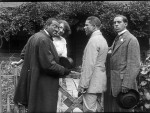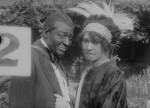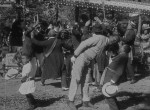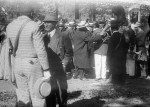 New York City’s Museum of Modern Art has discovered footage of a previously unknown 1913 film with vaudeville and Broadway pioneer Bert Williams starring in a cast of all black actors. It’s not a completed film that a movie theater would have received, but rather seven reels of unassembled daily rushes, multiple takes from each scene, that the director and editor would later edit together into the finished picture. The museum discovered the footage in its collection of 900 negatives from the Biograph studios that were rescued from destruction by MoMA’s first film curator, Iris Barry, when the company’s Bronx warehouse closed in 1939.
New York City’s Museum of Modern Art has discovered footage of a previously unknown 1913 film with vaudeville and Broadway pioneer Bert Williams starring in a cast of all black actors. It’s not a completed film that a movie theater would have received, but rather seven reels of unassembled daily rushes, multiple takes from each scene, that the director and editor would later edit together into the finished picture. The museum discovered the footage in its collection of 900 negatives from the Biograph studios that were rescued from destruction by MoMA’s first film curator, Iris Barry, when the company’s Bronx warehouse closed in 1939.
 It is the earliest surviving film to feature an all-black cast, and is among the earliest ever shot. The Foster Photoplay Company, a Chicago film production company founded in 1910 by theatrical promoter and entertainment journalist William Foster, released what is thought to be the first all-black picture, The Railroad Porter, in June of 1913. MoMA researchers discovered that the Bert Williams film was shot in September of 1913. None of the early Foster Photoplay movies have survived. (Unrelated but interesting coincidence: William Foster worked as a publicity promoter for Bert Williams and his partner George Walker’s groundbreaking 1903 musical In Dahomey, the first full-length musical comedy written and performed by African-Americans to be staged in a Broadway theater, and its equally successful 1906 follow-up Abyssinia.)
It is the earliest surviving film to feature an all-black cast, and is among the earliest ever shot. The Foster Photoplay Company, a Chicago film production company founded in 1910 by theatrical promoter and entertainment journalist William Foster, released what is thought to be the first all-black picture, The Railroad Porter, in June of 1913. MoMA researchers discovered that the Bert Williams film was shot in September of 1913. None of the early Foster Photoplay movies have survived. (Unrelated but interesting coincidence: William Foster worked as a publicity promoter for Bert Williams and his partner George Walker’s groundbreaking 1903 musical In Dahomey, the first full-length musical comedy written and performed by African-Americans to be staged in a Broadway theater, and its equally successful 1906 follow-up Abyssinia.)
 Unlike the Foster pictures which were created, shot and performed by black artists, only the actors in the recently discovered footage were black. They were employed by the famed Biograph Company, the film production company which launched the careers of D. W. Griffith, Mack Sennet, Mary Pickford, Lilian Gish, Mabel Normand and Lionel Barrymore. Biograph hired Bert Williams, who by then was hugely famous for his vaudeville routines, musicals and best-selling song recordings, to star in their all-black comedies. He had to wear blackface, which is as incongruous as it is gross considering that none of the other actors (that I can see in the stills, at least) are in blackface.
Unlike the Foster pictures which were created, shot and performed by black artists, only the actors in the recently discovered footage were black. They were employed by the famed Biograph Company, the film production company which launched the careers of D. W. Griffith, Mack Sennet, Mary Pickford, Lilian Gish, Mabel Normand and Lionel Barrymore. Biograph hired Bert Williams, who by then was hugely famous for his vaudeville routines, musicals and best-selling song recordings, to star in their all-black comedies. He had to wear blackface, which is as incongruous as it is gross considering that none of the other actors (that I can see in the stills, at least) are in blackface.
Even though it includes elements of minstrelsy, the general subject matter and approach does appear to be more in keeping with the “race films” that Foster and other black producers made to counter the ugly stereotypical caricatures of on-screen minstrel pictures.
Of historical relevance is the display of adult romantic feelings between black performers, which was largely considered unacceptable to white audiences into the first two decades of the 20th century. In the film, a repeated, lengthy kiss between Williams and his costar appears to be the earliest surviving portrayal of a serious romantic relationship between black characters on film. The film also features a lengthy early example of African American vernacular dance, with a nearly two-minute, full-cast performance of a cakewalk, the dance that Williams and partners George Walker and Aida Overton Walker had made an international sensation with theater audiences and the white upper class around 1900.
Although no main title, intertitles, script, or production credits have survived with the film, MoMA’s curators tried to reconstruct the film’s narrative, ultimately piecing together what appears to be a middle-class comedy centered on the membership of Williams’s character in a black social club, with an additional plotline concerning Williams and rival suitors vying for the hand of the local beauty after a day of fairground activities, a bit of larceny, and a night of exhibition dancing.
 The plot and characters of the film aren’t the only historically significant elements of this find. There’s also behind-the-scenes footage of the black cast interacting with the white crew on set in New York City and on location in what curators believe is Englewood, New Jersey.
The plot and characters of the film aren’t the only historically significant elements of this find. There’s also behind-the-scenes footage of the black cast interacting with the white crew on set in New York City and on location in what curators believe is Englewood, New Jersey.
The unedited rushes and MoMA’s research will go on display at the museum’s 100 Years in Post-Production: Resurrecting a Lost Landmark of Black Film History exhibition on October 24th. The assembled footage will be screened at MoMA’s 12th annual film preservation festival To Save and Project on November 8th.
Meanwhile, here’s a 1916 Biograph picture starring Bert Williams that has survived intact. As with the cakewalk scene in the recently discovered film, A Natural Born Gambler features one of Bert Williams’ most famous vaudeville routines. It’s the final scene of the picture (beginning at 19:30) in which Williams pantomimes an entire poker game alone.
The Internet Archive, bless its generous heart, has an impressive collection of Bert Williams’ music. His recordings were wildly successful, selling in the hundreds of thousands back when a record that moved 10,000 copies was considered a best-seller. His most famous was probably Nobody, but my favorite is 1920’s When The Moon Shines on The Moonshine both because it’s catchy and because it’s such a perfect little window into the first year of Prohibition.